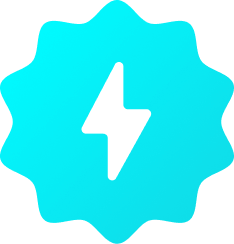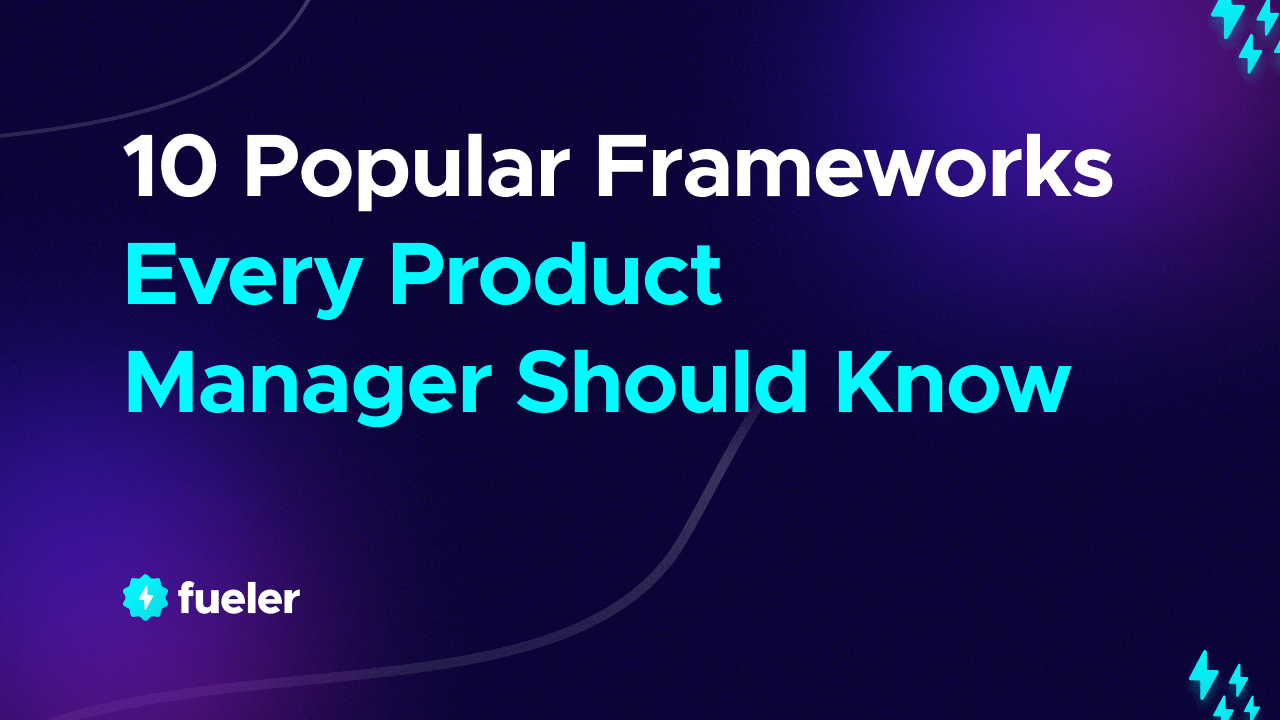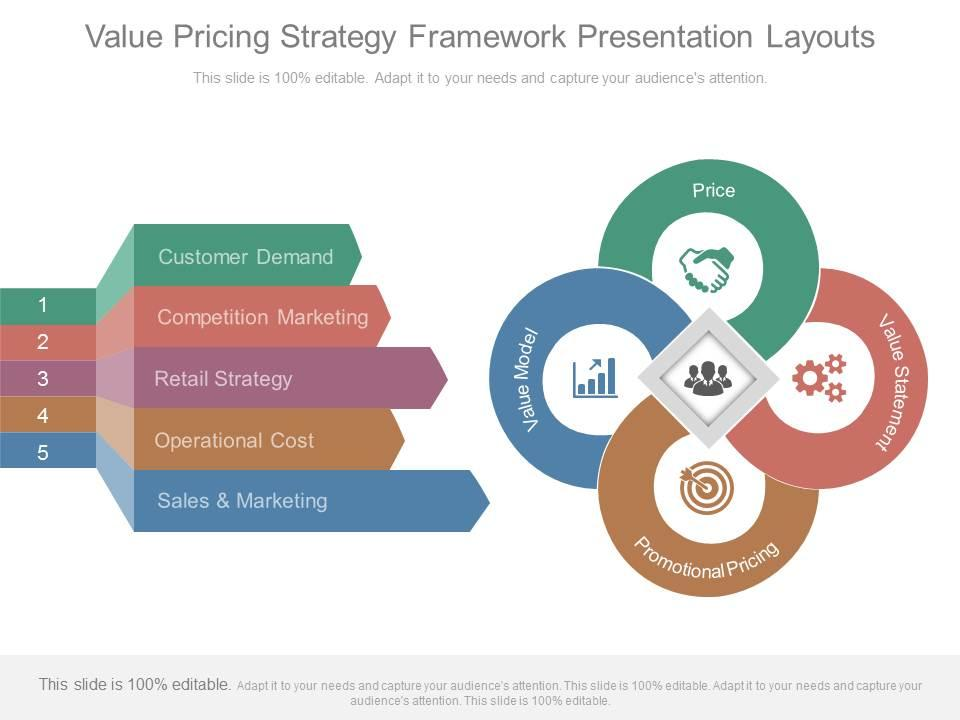10 Popular Frameworks Every Product Manager Should Know: A Comprehensive Guide with Use Cases and Examples

Team Fueler
02 Dec, 2023

Did you know that about 49% (that’s almost half!) of the countries around the world do not have a consistent Product Management Process?
Therefore, the phrase - “Frameworks are the key to Product Manager’s Success” might be true… if not entirely. But we won’t be able to determine or come to a conclusion unless we learn and apply these frameworks in real-time.
So, in this article - let’s fuel up our knowledge of the 10 popular Product Management frameworks, learn about their use cases, and examples and supercharge our Product Management expertise!
What is a Product Management Framework? Should you even care?
Before getting into the the ingredients and recipe, let’s understand what the dish is about right? No, I am not talking about food but Product Management Frameworks here :).
A product management framework is a set of tools and processes that help product managers guide a product through its lifecycle. The framework can help with everything from ideation and prioritization to launch and post-launch monitoring. To further optimize these processes, many companies are now incorporating product engineering services to enhance product design, development, and scalability efficiently.
Some of the common frameworks (ten of which we will discuss vividly in this article) are HEART, CIRCLES, STAR, and North-Star Metric. Each framework will have its own use case and this will largely depend on the product, industry, target market, business goals, product’s maturity, and last but not least - the Product Manager who’s using it! In practice, hiring a fractional CPO can provide strategic leadership without the full-time commitment, helping refine frameworks like North-Star Metrics or STAR to better align with evolving objectives.
But… should you even care about using these frameworks?
My short answer would be - YES!
Let’s see some of the benefits of using these Product Management Frameworks -
- Frameworks can help product managers to be more systematic and organized in their approach.
- They can help to make sure that all stakeholders are on the same page and that everyone is working towards the same goals (including the business itself!).
- Product managers can use frameworks to improve communication and collaboration between different teams, resulting in improvements in productivity and time management. This is especially important in specialized fields like oncology practice management, where coordinating between clinical, administrative, and technical teams is crucial for delivering efficient and compliant care.
- They can help to reduce risk and increase the chances of Product success.
Sound’s life-saving, isn’t it? Now, it’s time we explored 10 Popular Product Management Frameworks that might have the potential to sky-rocket our product success!
10 Popular Product Management Frameworks with Use Cases and Examples
A. North Star Metric
A North Star metric is a metric that measures the core value that your product delivers to your customers. It is the one metric that, if you improve it, will have the biggest impact on your business.
Wait… that’s the textbook definition to give you a gist.
Let me give you some interesting facts about NSM for a better understanding:
Basically, North Star is a metric that all your company/product’s features and improvements should be directed towards. As simple as that!
So, what else?
- It captures all the core values that your product delivers to customers and is a leading indicator of future success and revenue.
- Unlike its traditional definition, a product can have more than one North Star Metric.
- Holds a Product and Product Team(s) accountable to outcomes against output!
- The NSM has two main pillars: The Product Vision Statement and the key metric that serves the current product strategy.
Example
Some examples of the North Star Metric from popular brands:
- WhatsApp - The number of messages a user sends per day.
- Walmart - Purchases made per customer session.
- Airbnb - The number of nights booked.
- Medium.com - The Total Time Spent Reading.
So, if whatsapp team is working on a feature, they will take an evaluation if this feature will in any way increase the number of messages sent by a user or not and take a decision based on this.
You get the gist, right? But… how can you use it in your product in the best way?
Use Case
NSM use cases Industry wise:
B2B Saas -
- Monthly-recurring revenue (MRR)
- The number of On Trial Accounts with X users.
Consumer Tech -
- User Retention
- Daily Active Users (DAU)
E-commerce -
- Customer Lifetime Value (CLV)
- Number of Weekly customers completing their purchases.
How do you choose a North Star Metric for your business?
A good…great North Star Metric has the following criteria:
- It should be directly related to your business goals.
- It has to be measurable and trackable at the same time.
- It must be actionable.
- It needs to be unique to your product.
Ask yourself - “What metric encapsulates all of the above?” and find yourself surprised!
B. Jobs-To-Be-Done (JTBD)
Jobs to Be Done (JTBD) is a theory that says customers don't buy products, they "hire" them to get a job done. The job is the underlying problem or goal that the customer is trying to fulfill.
The product is just one of many possible solutions to the job so the main focus here is to investigate the problem at hand and aim for the outcome.
Here are some things to keep in mind for JTBD -
- According to JTBD, customers hire the product/service to get the job at hand done.
- The need statements defined according to JTBD are valid for years together.
- JTBD gives insights into the job i.e. problem at hand in a way that has the potential to differentiate a company in its value proposition against its competitors.
- Jobs for the customer here also consist of circumstances + emotions + social dimensions.
Bottom line is that JTBD is about really understanding what people want and need, so companies can make products and services that truly make sense for them.
Example
Let’s think of it this way -
Assume that you are driving on the freeway but are thirsty and hungry - now a milkshake company at the side of the road will play with this desire of yours and advertise you to buy their product. However, you understand the outcome here, right?
To fulfil your hunger and thirst and this can be done in multiple ways -
- Head home, cook dinner, and drink water.
- Go to a restaurant and have food and beverages or water.
- Purchase snacks like protein bar and water from a grocery store
- Go for that milkshake the company has been advertising to you to quench your thirst and fulfill your little hunger.
Now, keep this in mind - the milkshake has the value proposition that you can have this on the go while driving (assuming you are driving a car on the freeway), not get your hands dirty and at the same time enjoy the taste.
In any case, the customer (which is you here) is hiring the milkshake to get the job done!
Use Case
Here are some practical examples of how Jobs To Be Done (JTBD) theory can be used on various aspects of a Product/Service:
- Creating New Products: JTBD helps find new product ideas by understanding what customers need.
- Understanding Customers: JTBD helps group customers based on their needs. This is like sorting people into different groups by what they want.
- Reducing Customer Loss: JTBD helps know why customers leave a service. This is important for finding ways to make the service better.
- Setting Prices: JTBD helps decide how much to charge for things. By knowing what customers want, companies can choose prices that are reasonable and fair.
- Effective Marketing: JTBD guides making ads that work better. It's like talking to customers in a way that matters to them.
C. First Principles
In Brandon Chu’s words (GM, Platform @ Shopify), a first principle is a “basic, foundational proposition or assumption that cannot be deduced from any other proposition or assumption.”
Keeping the Jargons aside, basically what First principles mean for a Product Manager is to think in a simplified way and communicate the same to team members and stakeholders. Breaking down the problem to its simplest level and achieve the same. This lets everyone move in the same direction and make decisions in terms of what is actually important for the product.
The First Principle has two main principles -
- Principle A - Maximize impact on the mission: Based on the left side of the brain associated with logic and reasoning and is mainly helpful in developing product strategy. This essentially needs three inputs - Goal, Environment Signal, and Constraints.
- Principle B - Accomplish everything through others: Based on the right side of the brain linked with people and chaos dictates that Product Managers are purely generalists and coaches (who don’t play). This principle says that a PM should know when they should partner, support, or lead the team.
Example
- One beautiful example of First Principles demonstrated by Brandon Chu about his work at Shopify - Developers are advised to treat the developer platform features as Lego Blocks.
- What does this mean?
- Just like Lego Blocks can be combined together to build anything, developers on the platform must be able to use any combination of features to build an application.
- Yes, it makes sense now why Shopify is a powerful e-commerce platform - the PMs got the first principle right!
- Another interesting example is Carl Pei’s first principle Nothing Phone - Phones are getting boring. How do we make them more visually fun?
Use Case
Some use cases of First Principles could be the following;
- Decision-Making: Imagine you have a big problem to solve, like making a super cool new gadget. First Principles thinking is like taking that problem apart, piece by piece, to see how it really works. This helps the gadget makers (here, the Product Managers) understand it really well.
- Problem Solving: Sometimes, the gadget makers face problems that nobody has ever seen before. Instead of doing what everyone else does, they use First Principles thinking. That means they don't follow old rules or copy others. They start from scratch and ask basic questions. This helps them come up with clever solutions that fix the real problem.
- Use Case Analysis: Think about a microwave. When gadget makers (PMs) want to make it better, they think about what it's really supposed to do. For a microwave, that's heating food, boiling water, and defrosting. They focus on these important jobs and make the microwave work better for them.
D. The Hook Model
Do you find yourself opening Instagram or WhatsApp first thing in the morning when you wake up?
If your answer is yes, then keep all the motivational quotes and videos aside - it's something you really can’t help.
Why? Because you are hooked!
This is precisely what the Hook Model by Nir Eyal talks about. The Hook Model is based on the simple rule that - “Connect a user’s problem to your solution with enough frequency to make it a habit.”
The Hook Model talks about the 4 steps that are the building blocks to manufacture desire and turn products into habits:
- Trigger: This is the actuator of the Behaviour and again has two types - external triggers and internal triggers.
- Action: The Fogg Behavior Model defines that someone would perform an action only in anticipation of a reward. Think why do you post something on social media? To get likes, comments, and other forms of attention!
- Variable Rewards: Forms the actual reward and is of three types - Tribe, Hunt, and Self.
- Investment: Asking the users to invest their time, money, effort, data or social capital like followers.
Example
Let’s take the example of Duolingo (the Gamified Language Learning App):
- Trigger (Part 1 - External Trigger): Duolingo gives users an external trigger by sending them notifications like "It's time to practice your language skills." These notifications prompt users to open the app.
- Action: When users open Duolingo, they engage in short and fun language lessons. This action is easy to do and doesn't take much time, making it user-friendly.
- Variable Rewards: Duolingo rewards users with badges and a sense of accomplishment when they complete lessons or reach milestones. Users feel proud of their progress, which keeps them motivated to continue learning.
- Investment: As users earn more badges and make progress, they become invested in their learning journey. They may set goals, connect with friends, or invest time and effort into improving their language skills.
Trigger (Part 2 - Internal Trigger): Duolingo also creates internal triggers through streaks. Users start feeling a sense of achievement and want to maintain it. They develop an internal motivation to continue using the app regularly.
Use Case
Some use cases of the Hook Model are as below:
- Social Media Engagement: Social media platforms like Facebook and Twitter use the Hook Model to keep users engaged. They employ triggers (notifications), actions (scrolling and liking), variable rewards (likes, comments, shares), and investments (building a profile, and sharing images) to create habits of frequent usage.
- User Research: User researchers and product design teams use the Hook Model to understand and design user experiences effectively. They apply triggers (user needs), actions (interaction with the product), variable rewards (user satisfaction), and investments (user engagement) to improve product usability and engagement.
- Creating Habitual Behaviors: The Hook Model helps businesses create products and services that customers use habitually. By implementing triggers (reminders), actions (product usage), variable rewards (benefits), and investments (loyalty programs), companies can turn occasional customers into habitual ones
E. AARRR (Pirate Frameworks)
Do you like Pirates? Whether your answer is yes or no, probably you will like the Pirate Framework. And no… it was definitely not introduced by Pirates!
The AARRR framework developed by Dave McClure defines 5 user behavior metrics that talk about the entire Customer Lifecycle -
- A — Acquisition (How do users find you?).
- A — Activation: The core value of the Product is tested (Do users have a great first experience?).
- R — Retention (Do users come back?).
- R — Revenue (How do you make money?).
- R — Referral (Do users tell others?).
Example
Here’s a hypothetical example of an online e-commerce store thriving on the Pirate Framework -
Acquisition: Imagine you have an online store. You decide to run Facebook ads to bring more people to your website. You spend $500 on ads and, as a result, 5,000 new visitors come to your site.
Activation: Out of those 5,000 visitors, 1,000 sign up for your newsletter, which means they are interested in your products.
Retention: Over the next few months, 600 of those subscribers keep opening your newsletters and visiting your store regularly. They've become loyal customers.
Revenue: From these loyal customers, you make $5,000 in sales.
Referral: These happy customers start telling their friends about your store, and you get 50 new customers through word of mouth.
Use Case
For any use case, whether it is while building a feature of a product or even a personal blog or newsletter, these are some of the main steps to follow to apply the AARRR framework:
- Identify your product’s AARRR Pirate metrics: Are your acquisition channel Ads, or SEO? Is your activation metric newsletter sign-ups? Similarly for Retention, Referral, and Revenue.
- Set up processes to track and analyze these AARRR pirate metrics: You can take the help of Analysis tools like Google Analytics, Mixpanel, Amplitude, etc. to keep track of these metrics.
- Run tests (A/B tests) for all stages of user behavior to find better approaches: This will help you see which versions drive more growth for each metric.
- Use these metrics to improve initiatives and make better decisions: For the product as a whole, whether on the development, product, or marketing end - these metrics will largely help you see the bigger picture and make better decisions.
F. HEART
Google, the heart of the majority of internet searches today also introduced the HEART framework.
As the name suggests, though HEART is an acronym (yet again!) is related to emotions… the emotions of the user disguised as UX metrics of Product Research.
Each metric of the HEART framework (from the perspective of Quality of User Experience) is measured against the trio - Goals, Signals, and Metrics (from the project/product goals perspective).
So, the HEART stands each for the measure of -
H for Happiness: How happy are users with your product?
E for Engagement: How often are users interacting with your product?
A for Adoption: How many users are initially adopting your product?
R for Retention: Are users coming back to your product?
T for Task Success: Are users able to complete tasks efficiently?
Example
Some examples for each of the metrics in HEART are:
- Happiness — User attitudes like Net Promoter Score, Satisfaction, etc.
- Engagement — Level of user involvement like frequency and intensity.
- Adoption — Rate at which new users join a product or feature like registering on an app.
- Retention — Rate at which existing users return to a product or feature like coming back to an abandoned cart.
- Task Success — User experience behaviors like efficiency, effectiveness, and error rate.
Use Case
Product Decision Making: The HEART framework helps teams decide what to improve in apps or websites by looking at those top 5 metrics. It makes the app better for users and helps the business.
UX Evaluation: HEART is like a checklist for designers and builders to see if an app or website is easy and fun to use. They check if people like it, use it a lot, if more people are starting to use it, if people keep coming back, and if people can easily do what they want.
Tying UX Objectives to Business Goals: HEART is a bridge that connects making the app better for users with making the business more successful. It shows how improving the app for users can help the business make more money or achieve its goals.
G. 5 C’s of Pricing
As professionals, freelancers, and even entrepreneurs we have often been puzzled over the pricing of our products and services and tend to give in to factors like customer budget.
To solve this (mainly for Product Pricing), the 5 C’s framework is here to the rescue.
The Five Critical C’s for Pricing stands for the following -
- Company: This takes into consideration the obvious measure - the cost incurred to the company. This includes everything from direct costs, and overheads to even trade discounts.
- Customers: Now, here we don’t consider the customer’s budget but rather how much they are willing to pay! There are two components to this - Your customer’s expected range, and their acceptable range within this.
- Competitors: Even if you have your USP defined, your customers might not think in the same way. So evaluate the pricing of the alternatives from the customer’s perspective as well.
- Channels: Do you have third-party distribution channels forming a bridge between you and your customer? Make sure the commission/charge is considered while pricing your product!
- Compatibility: One important thing that’s overlooked by many at least in the beginning (this can be fatal at times!) is compatibility between pricing and your objectives. Is your objective now to increase revenue? Or to increase the adoption rate? Price your products accordingly!
Examples and Use Cases
There are no specific examples for 5C’s so let’s take some use cases into consideration to understand it better -
- Company: An automobile manufacturer evaluates the cost of raw materials, labor, and manufacturing to determine the base cost of a car.
- Customer: A tech company may survey its customers to understand how much they are willing to pay for a premium software subscription.
- Competition: Airlines set ticket prices by considering the fares offered by other airlines on the same route.
- Channel: A product sold through an exclusive retailer might have a higher price point than the same product sold through a discount retailer.
- Compatibility: A luxury fashion brand may set higher prices to maintain a premium brand image and higher profit margins.
H. MoSCoW
No, we are not talking about the capital of Russia here (obviously). MoSCoW is a popular prioritization framework (one of my favorites!) and is used by Product Managers worldwide to prioritize features development and release.
It’s quite simple to understand and implement -
M - What is that Must Have feature that is Non-negotiable at all costs?
S - What is that Should Have feature that’s important but not as needed?
C - What is the Could Have feature that’s good to have but not a deal breaker?
W - What is that feature you Will Not Have since its not a priority at this time?
Example
Let’s consider the following scenario -
Suppose a software development company is tasked with creating a new mobile app for a client that focuses on a gamified product purchase experience. The client has several requirements, but they need a clear way to prioritize them.
Using MoSCoW we will be able to do so easily -
- Must-Have: The client specifies that the app must allow customers to order products, track their orders, and receive notifications. These are the core functionalities without which the app won't be useful.
- Should-Have: The client identifies additional features that are important but not critical for the initial release, such as a customer review section or a loyalty program. These features should be included if time and resources permit.
- Could-Have: The client also has some ideas for nice-to-have features, like integrating social media sharing or adding advanced analytics. These features could be implemented if everything goes smoothly, but they are not a priority.
- Won't-Have: The client realizes that some ideas, like adding virtual reality features, are not feasible within the current project scope. These are marked as won't-have for this release.
Use Case
Some of the use cases of this prioritization framework are the following:
- Prioritize tasks in a project (this is obvious!): When you're working on a project, you probably have a list of tasks that need to be done. The MoSCoW framework can help you prioritize these tasks so that you know what to focus on first.
- Prioritize features in a product roadmap: If you're developing a product, you need to decide which features to prioritize. The MoSCoW framework can help you do this by identifying the features that are most important to your users and your business.
- Prioritize customer requests: If you're a business, you're likely to receive customer requests for new features or changes to your product. The MoSCoW framework can help you prioritize these requests so that you can focus on the ones that are most important to your customers.
- Prioritize bugs: If you're developing software, you're likely to find bugs. The MoSCoW framework can help you prioritize these bugs so that you can fix the most important ones first.
- Prioritize anything else that needs to be prioritized: The MoSCoW framework can be used to prioritize anything that needs to be prioritized, such as tasks, features, customer requests, bugs or even launching the product itself!
I. CIRCLES
Heard of those questions (especially Product Managers) that say “Design X for Y”? That is exactly what the CIRCLES framework helps you solve!
Lewis C. Lin, who is also the author of Decode and Conquer created this framework to help ask the most essential questions for solving any Product Design challenge.
The seven main steps of the CIRCLES framework are as follows:
- Comprehend the situation (Ask all the 4 Ws and 1H: What? Why? Who? Where? How?)
- Identify the customer
- Report customer’s needs
- Cut, through prioritization
- List solutions
- Evaluate tradeoffs
- Summarize your recommendation
Example
Let’s say we need to design a new classroom curriculum.
Using the CIRCLES framework, we can solve this in the following way:
- C (Categorize): Categorize curriculum components - subjects, grade levels, learning objectives, and specific needs.
- I (Identify): Identify student needs and educational objectives.
- R (Research): Research existing curricula, methodologies, and best practices.
- C (Create): Generate curriculum structures and teaching methods.
- L (Look at Trade-offs): Analyze trade-offs - resources, time, and effectiveness.
- E (Evaluate): Assess the consequences of each design, focusing on meeting objectives and student engagement.
- S (Summarize): Summarize the recommended curriculum design and explain its alignment with needs and objectives.
Use Case
Some use cases of CIRCLES for Product Managers (other than solving Product Design Interview questions, of course) are as follows:
- Prioritize Product Roadmap, features, user feedback, and execution.
- Let Product Managers ask the right questions from the beginning itself.
- Keep an open mindset during the entire process instead of getting to the conclusion beforehand.
J. STAR/SOAR
Have you ever been asked about explaining a situation in an interview or in general? The STAR framework helps you craft your storytelling in the best way possible!
While explaining real-life scenarios use the following components in the STAR framework -
- S — Situation
First, lay out a situation and give the required details.
- T — Task
Highlight all the tasks and the responsibilities given to you.
Mention any obstacles that you faced.
- A — Action
How did you take the action?
What were the important steps related to it?
- R — Result
Discuss the outcomes and results of your activities related to the given situation.
Example
Let’s go through a brief example to understand this better:
Your interviewer asks you - “Tell me about a time when you achieved a goal that you initially thought was out of reach.”
Let’s answer this using STAR -
- Situation - “In my previous product management role, my company made the decision to focus primarily on a particular feature and was looking to increase the engagement for that more aggressively”.
- Task - “As the product manager working on the feature, my target was to come up with solutions and sub features to increase engagement by 30%.”
- Action - “I started by looking at secondary data like session recordings and heatmaps Then proceeded with customer interviews…and finally prioritized some of the solutions we came up with”
- Results - “As a result of our efforts and the sub features we introduced… we were able to pull up the engagement by 40%!”
Use Case
Other than interviews, there are some other use cases for the STAR frameworks:
- Performance reviews: STAR can be used to help employees reflect on their performance and identify areas for improvement.
- Coaching: STAR can be used to help employees identify their strengths and weaknesses, and develop strategies for improvement.
- Project management: STAR can be used to help ensure that projects are on track and that teams are working together effectively.
- Problem solving: STAR can be used to help identify the root cause of problems and develop solutions.
Key takeaways
In this article, we discussed the 10 Popular Product Management Frameworks along with their respective use cases and examples - North Star Metric, Jobs-To-Be-Done (JTBD), First Principles, The Hook Model, AARRR (Pirate Frameworks), HEART, 5C’s of Pricing, MoSCoW. CIRCLES, and STAR/SOAR.
Now it's time to ask yourself, how you can maximize each framework’s use case in your work and even in life in general!
Here are some examples of how you can use your freshly gained knowledge of Product Management Frameworks -
- If you are an aspiring Product Manager, think of creating case studies around these Frameworks and start building your dream Proof of Work Portfolio.
- If you are an early-stage Founder building a product or a Product Manager working in an organization, implement these frameworks in each of their capacities - Pricing, Prioritization, Design, etc. to create the best version of your Product!
If you are looking for someone to amp up your Product with the right set of frameworks and strategies, let’s talk!
About the Author:
Diksha is a T-Shaped AI Product Manager with an Engineering Background (CS) | 2x founder | Has extensively worked in B2B Saas, eCommerce and Service-Based industries | Talks about entrepreneurship, product management and growth, content marketing.
References
- https://medium.com/@dikshapatrob/10-popular-product-frameworks-a-brief-guide-66494bdc7537
- https://www.consuunt.com/hook-model/
- https://uxdesign.cc/using-the-hook-model-for-user-research-cad3d17f81e7
- https://www.productplan.com/glossary/hook-model/
- https://www.productplan.com/glossary/aarrr-framework/
- https://ahrefs.com/blog/aarrr-metrics-framework/
- https://amplitude.com/blog/heart-framework-software-ux
- https://www.marketingtutor.net/5-cs-of-marketing-situation-analysis/
- https://www.productplan.com/glossary/circles-method











